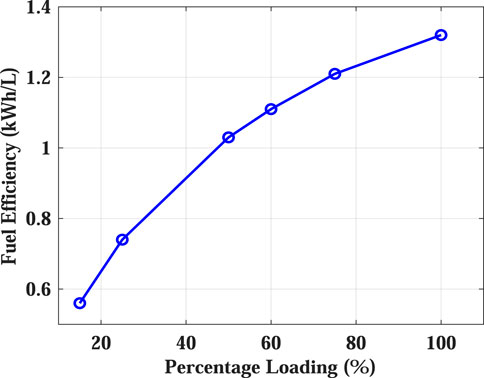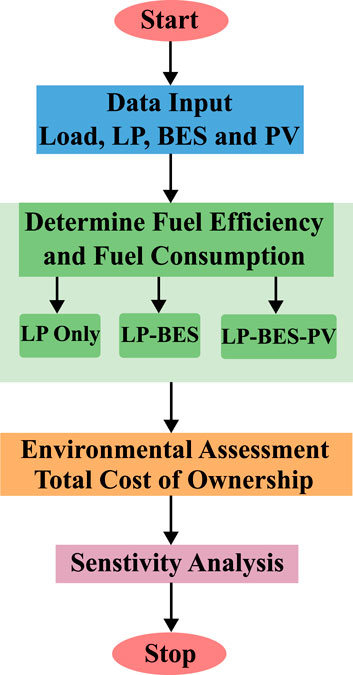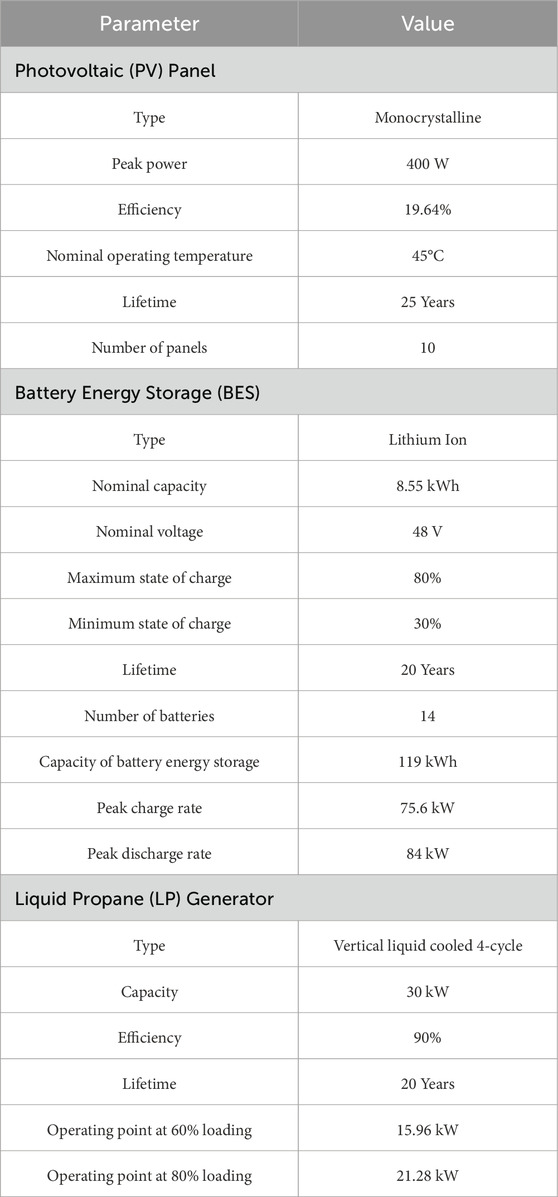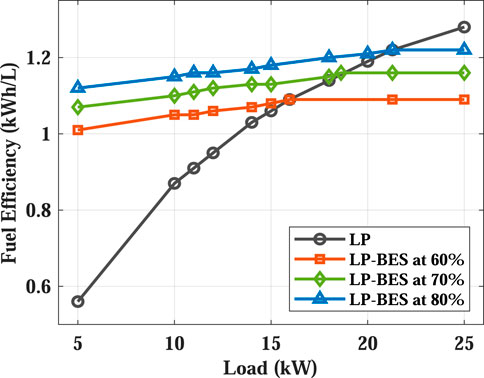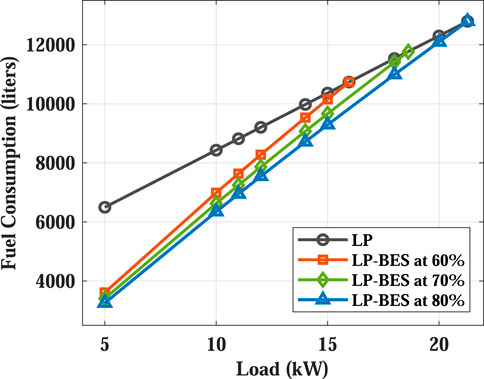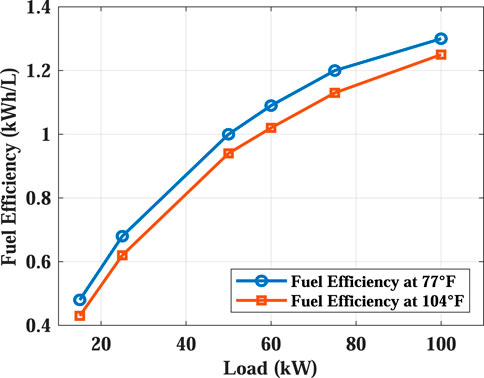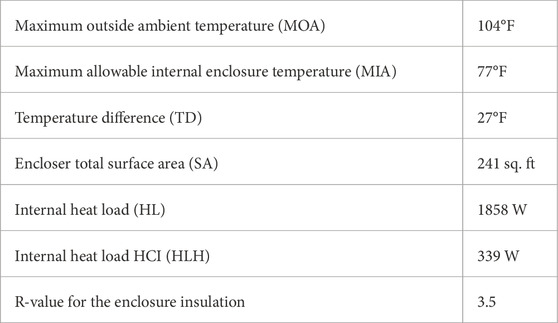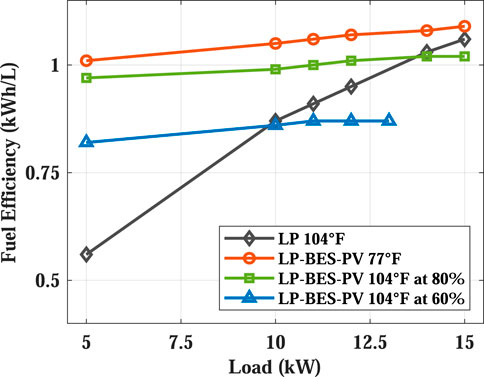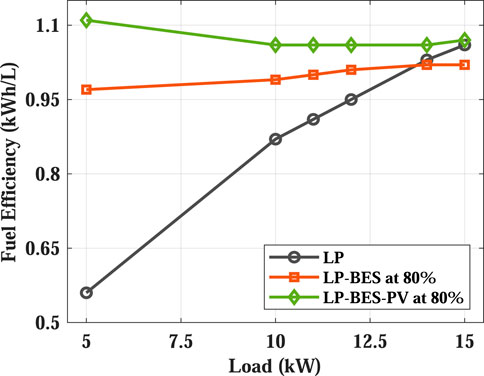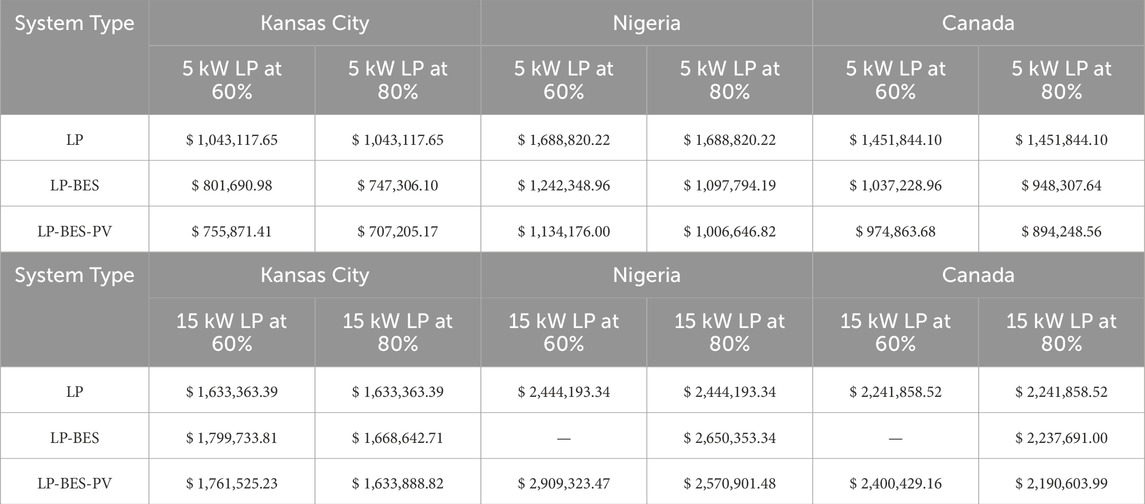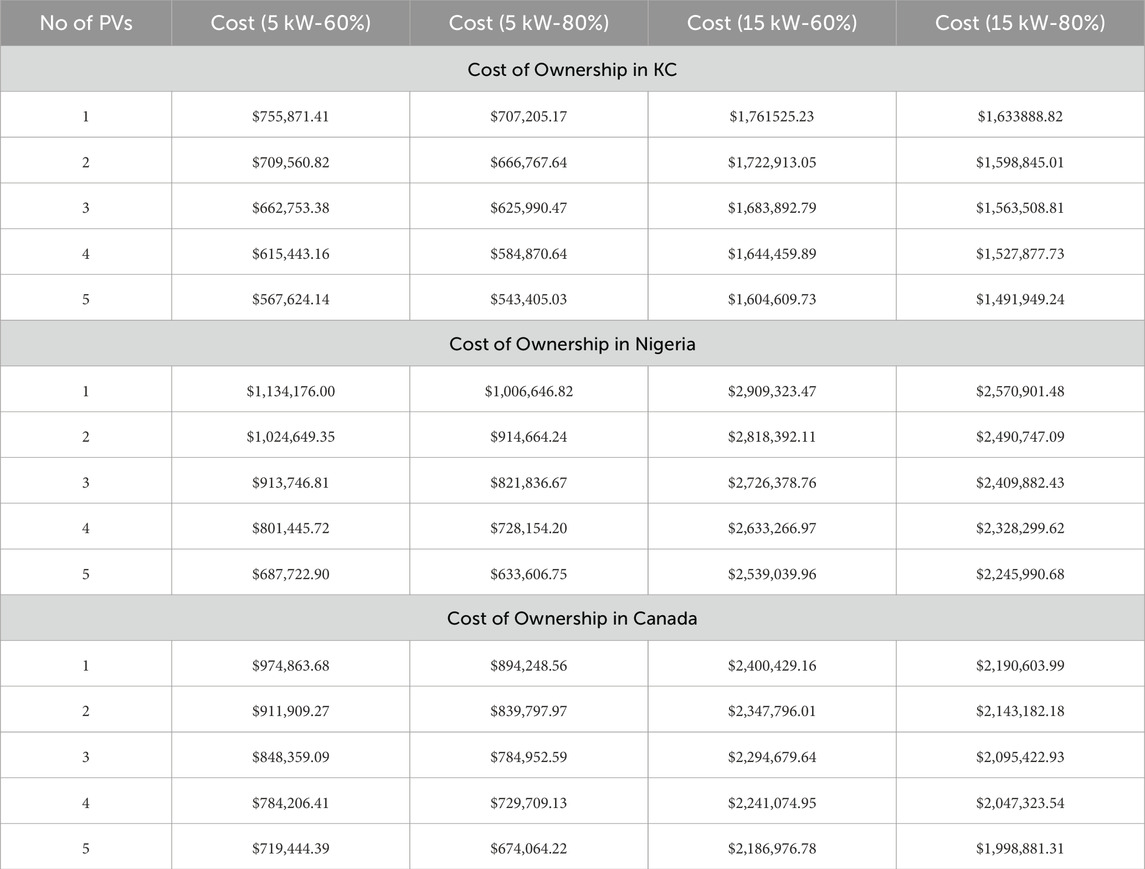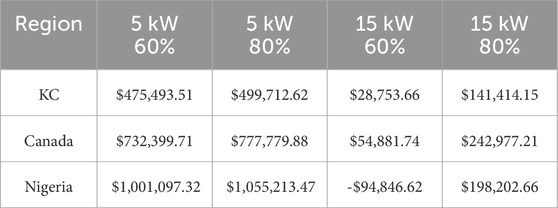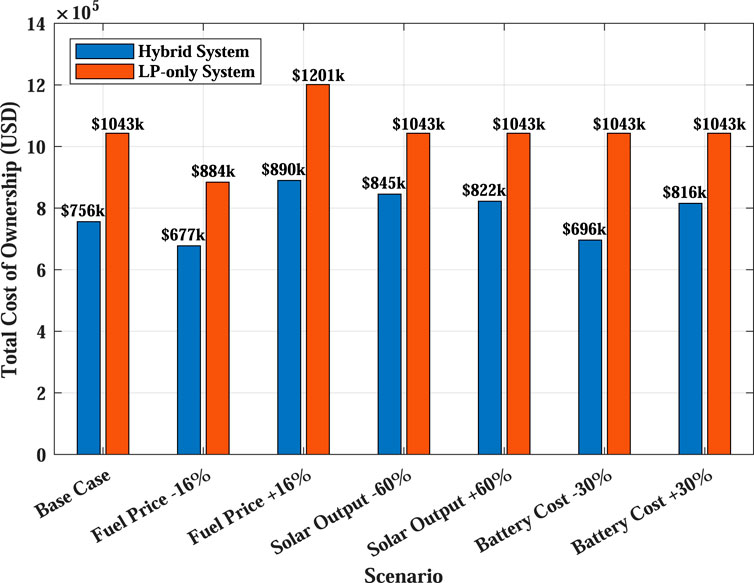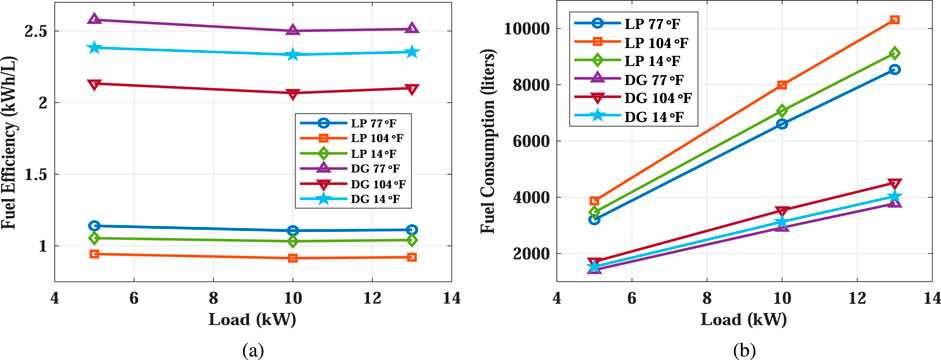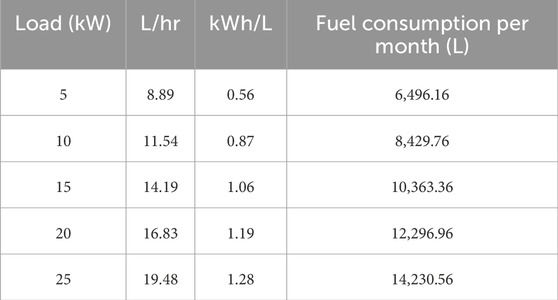- 1Division of Energy, Matter and Systems, University of Missouri Kansas City, Kansas City, MO, United States
- 2Missouri Institute for Defense and Energy, Kansas City, MO, United States
Hybrid power supplies leveraging renewable energy sources have emerged as pivotal solutions ensuring uninterrupted power for critical applications like telecom towers in remote regions. However, limited research has evaluated the real-world performance, fuel efficiency and economic viability of commercially deployed systems particularly those using liquid propane (LP) as the primary fuel source. This paper evaluates the feasibility and efficacy of a hybrid power supply integrating a LP generator, Battery Energy Storage (BES) and Photovoltaic Panel (PV). Three configurations—LP only, LP-BES and LP-BES-PV are assessed using a spreadsheet based simulation across multiple loading conditions and geographic regions, including Canada, Nigeria and Kansas City. Results show that integrating BES and PV can reduce annual fuel consumption by over 55%, significantly lowering operating costs and greenhouse gas emissions. A 20-year total cost of ownership (TCO) analysis demonstrates that hybrid configurations can achieve up to 32% cost savings compared to LP only systems. Environmental impact is quantified using EPA emission factors, revealing that the hybrid system can avoid more than 65.8 metric tons of CO2 annually. Sensitivity analysis further examines the impact of fuel prices, solar energy output and battery costs on system performance. The findings underscore the operational and environmental benefits of hybridizing LP based systems with renewable technologies. While LP based systems offer unique advantages for remote deployments, such as fuel stability and ease of storage, this study confirms that integrating PV and BES significantly enhances performance and long-term cost-effectiveness.
1 Introduction
As communication networks extend into remote and challenging terrains, ensuring reliable power becomes imperative. Likewise, emergency power solutions are crucial to support vital lifelines for response teams and communities during natural disasters. Remote regions, including mountainous and desert areas, necessitate self-sustaining Hybrid Power Systems (HPS) capable of uninterrupted operation. However, these environments present unique challenges, such as availability and cleanliness of fuel, extreme weather23 conditions and high altitudes, which can lead to derating and decreased fuel efficiency in HPS. Hence, evaluating the performance of HPS under varying temperatures and altitudes becomes essential to enhance their reliability and efficiency in diverse operational contexts.
In recent years, numerous scholarly articles have delved into the techno-economic evaluation of HPS, typically integrating renewable energy sources alongside diesel generators. Such systems, particularly those incorporating PV arrays and diesel generators, hold promise in delivering reliable electricity to remote areas lacking access to conventional power grids Kumar and Manoharan (2014). Rohani et al. (2010), for instance, illustrated the efficacy of hybrid power systems utilizing PV, wind, fuel cells and batteries in meeting the energy demands of remote regions while remaining economically viable. In a related study, researchers in reference Madziga et al. (2018) explored three distinct off-grid hybrid configurations integrating PV, diesel generators and battery storage to address electrification challenges in South Africa. Their findings underscored that PV coupled with battery storage is the most cost-effective and environmentally sustainable option. Similarly, the investigation conducted by authors in Kumar et al. (2020) employed techno-economic and environmental modeling to advocate for a PV, diesel generator and battery storage configuration as the optimal solution for a hybrid renewable energy microgrid serving a residential community.
The advancement of hybrid renewable energy systems is pivotal in enhancing energy efficiency and sustainability within the telecommunications sector. One notable study illustrates a hybrid power system that integrates PV panels, wind turbines, diesel generators and battery energy storage, aiming to supplant traditional diesel-only systems to improve reliability and sustainability Asghar et al. (2024). Similarly, research into solar PV hybrid systems combined with BES emphasizes their capability to deliver uninterrupted electricity, thereby eliminating the need for diesel generators entirely Rao Deevela et al. (2022). In addition to these developments, one proposal advocates using underused institutional building rooftops for hybrid renewable energy systems, including PV-Grid and PV-Battery-Grid configurations. This approach significantly reduces reliance on carbon emitting fuels while ensuring a reliable power supply Alam et al. (2024). Further analysis evaluates solar PV array based hybrid systems, exploring optimal configurations that maintain power reliability during grid outages Deevela et al. (2021). Furthermore, a hybrid energy system that integrates solar panels, wind turbines and battery storage is designed to enhance telecommunications reliability while minimizing diesel generator usage Maoulida and Aboudou (2021).
Conducting a thorough techno-economic analysis is essential for assessing the feasibility of hybrid systems in telecommunications. For instance, one analysis evaluates a PV/Supercapacitor hybrid power system tailored for marine applications, focusing on financial metrics such as the levelized cost of electricity (LCOE) and discounted payback time to ascertain economic viability Qiu et al. (2019). Another study employs the Hybrid Optimization Model for Energy (HOMER) to assess micropower systems for off-grid telecommunication towers, identifying optimal renewable energy configurations that include solar, wind and pico-hydro solutions Abdulmula et al. (2022). Further research delves into the life cycle costs of renewable energy options for telecom towers, evaluating economic feasibility and environmental impacts Alkhrijh and Wonsuk (2024). A carbon neutral energy system that incorporates solar PV, battery storage and hydrogen technologies is also analyzed, focusing on performance optimization and economic sustainability Jansen et al. (2021). Additionally, a hybrid renewable energy system (HRES) that utilizes liquid propane generators, PV panels and battery storage is explored for its potential to enhance fuel efficiency and meet the energy demands of telecommunications, thereby promoting sustainable growth in the industry Ali et al. (2024).
The transition to hybrid systems offers substantial environmental benefits. One study highlights the positive impact of replacing diesel generators with hybrid systems, underscoring reductions in carbon emissions and improved energy efficiency Zegueur et al. (2023). Moreover, a review of renewable energy systems for telecom towers emphasizes the importance of sustainable power solutions, which facilitate decarbonization and reliability Deevela (2024). Innovative methods for enhancing connectivity in remote areas are also under investigation. Research into tethered balloons as alternative telecommunications platforms evaluates their potential advantages and challenges, providing valuable insights into improving telecom services in isolated locations Ferrier et al. (2021). Furthermore, ensuring reliable backup power is critical for maintaining telecommunications during power outages. One proposed solution combines a reformed methanol fuel cell with batteries in a hybrid system, optimizing fuel efficiency and reducing emissions to ensure uninterrupted service Martinho et al. (2022). Additionally, integrating renewable energy sources with battery storage presents stable, off-grid power solutions for telecom towers Asghar et al. (2024). While a considerable body of literature has explored the techno-economic analysis of hybrid renewable energy systems, particularly focusing on metrics such as Net Present Value (NPV), LCOE and reductions in greenhouse gas emissions, there remains a dearth of studies that specifically examine the effects of integrating renewable energy sources and BES on the fuel efficiency and consumption of LP and diesel generators, which serve as primary energy sources in hybrid power supply systems.
Few commercially available products can seamlessly deploy in remote locations for critical applications like powering telecom towers, ensuring emergency power for public safety, and facilitating connectivity in tribal areas. Authors in reference Weber et al. (2015) proposed the development of a Small-Scale Mobile Hybrid Integrated Renewable Energy System (HI-RES) designed specifically to provide reliable and efficient emergency power during disruptions. Initial modeling and simulations conducted using HOMER software underscore the HI-RES system’s potential to deliver dependable power solutions. Existing portable and off-grid energy solutions, such as Renogy’s Lycan 5000 and the PowerCube 3000, are primarily designed for temporary or emergency power supply. These systems are generally not optimized for continuous operation and there is a lack of rigorous performance evaluation under extreme environmental conditions, varying load demands and real-world deployment scenarios. Moreover, prior research studies on hybrid energy systems often rely on idealized microgrid configurations without assessing the behavior of commercial, field deployable systems under diverse operational constraints. As a result, there remains a critical gap in both the literature and practice regarding the fuel efficiency, cost-effectiveness and environmental impact of integrated hybrid power systems tailored for mission-critical applications.
In response to these limitations, this study presents a detailed technical and economic assessment of a commercially available HPS system developed by HCI Energy HCI (2024). The HPS integrates a LP generator, PV panels and BES into a modular, transportable enclosure known as the Hybrid Cube. This system is engineered to provide reliable power to telecom towers and other mission-critical infrastructure in remote and off-grid environments. Unlike prior work, which often focuses on generalized renewable configurations or single component optimization, this study investigates the operational behavior of a fully integrated hybrid system under realistic load conditions and ambient temperature variations. It also evaluates long-term performance over a 20-year life cycle.
To comprehensively evaluate the system’s viability, the study includes the following key contributions:
The remainder of the paper is structured as follows: Section 2 describes the architecture of the HPS system. Section 3 presents the analytical framework used to derive fuel efficiency metrics under various generator loading scenarios. Section 4 details the simulation methodology, including component specifications and the environmental datasets used to replicate realistic operating conditions. Section 5 reports and discusses the core findings of the study, including fuel efficiency comparisons across system configurations, the influence of ambient temperature on generator performance, greenhouse gas emission reductions, total cost of ownership (TCO) analysis, a multi-parameter sensitivity assessment and a comparative evaluation of diesel and propane based hybrid systems. Section 6 explores the policy implications of the results with emphasis on their relevance to rural electrification. Section 7 outlines the limitations of the study and discusses key areas where further work is warranted. Section 8 concludes the paper by summarizing the key insights and identifying directions for future research and development.
2 Architecture of the hybrid power supply system
Figure 1 shows the configuration of the HPS system developed by HCI Energy. This system is designed to support the power requirements of telecommunication and mission-critical infrastructure by delivering regulated 48 V DC output, with or without grid availability. The system can accept AC input voltages of 120 V, 208 V or 240 V and can utilize energy generated from PV panels and/or wind turbines. Simultaneously, it supplies power to both 120 V/240 V AC and 48 V DC loads. All components are integrated into a rugged, transportable enclosure referred to as the Hybrid Cube, which is optimized for field deployment in remote environments.
The hybrid system operates primarily on solar power and BES, with the LP generator serving as a secondary source for battery charging and load support during low solar generation periods. This configuration allows for a substantial reduction in fuel consumption, depending on the PV and battery capacities, thereby increasing system sustainability and reducing operational costs.
A key feature of the Hybrid Cube is its controlled generator loading strategy, which is employed to optimize performance, enhance fuel efficiency and extend the operational lifespan of the genset. The generator’s output is limited to a maximum of 88% of its rated capacity, with typical operation maintained around 60% load and scaled up to 80% during periods of elevated demand. This load management approach reduces thermal and mechanical stress on the generator, lowers specific fuel consumption (L/kWh) and improves system resilience by reserving headroom for transient load fluctuations. Moreover, operating under partial load conditions minimizes component degradation, thereby reducing the frequency of maintenance which is an important advantage for deployments in hard-to-access or off-grid locations.
The system’s design also incorporates strategies to address environmental constraints such as ambient temperature extremes and reduced air density, which are common in high-altitude and high-latitude regions like Nigeria and Canada. These environmental factors often necessitate generator derating to prevent overheating and ensure efficient combustion. By intentionally limiting generator operation to below nominal capacity, the HPS integrates an inherent performance buffer that compensates for derating effects. This ensures reliable, stable operation across a broad range of environmental conditions, enhancing the system’s suitability for diverse geographic and climatic applications.
The HPS enclosure is shelter-mounted and engineered for rapid deployment and ease of transportation. The system supports modular expansion, including the addition of ground-mounted solar panels to reduce generator run time or to enable fully off-grid operation. A wind turbine option is also available and can be installed alongside or in place of PV panels, with the turbine tower mountable directly to the shelter structure.
HCI Energy’s Hybrid Cube has been successfully deployed in a range of real-world applications:
These deployments underscore the Hybrid Cube’s adaptability, resilience and efficiency in delivering sustainable power to critical infrastructure in remote and underserved regions.
3 Analytical formulation of fuel efficiency for the hybrid power supply system
The fuel consumption rates under varying load conditions, essential for assessing fuel efficiency, are derived from manufacturer provided data for the “Generac” 30 kW propane generator, which has a rated output of 26.6 kW Generac (2016). Table 1 presents the fuel efficiency metrics across different loading scenarios, while Figure 2 illustrates these variations graphically. The LP generator operates consistently at 60% load, as maintained by HCI, to prolong the unit’s lifespan. Analysis of Figure 2 indicates that fuel efficiency improves with increased loading, which aligns with expected performance trends. The unit “kWh/L” denotes kilowatt-hours per liter, representing the generator’s fuel efficiency by quantifying energy output relative to fuel volume consumed. The fuel consumption as a function of the load is presented in Table A1 in the Appendix.
3.1 Determination of fuel efficiency using energy balance equations
To evaluate the performance of the HPS system, it is essential to quantify fuel efficiency across different operating scenarios. This section develops an energy balance framework to estimate fuel consumption based on generator loading, battery charging behavior and auxiliary loads such as HVAC. The derived equations provide a systematic basis for comparing energy utilization in LP-only and hybrid configurations, allowing for consistent evaluation of efficiency under varying demand and environmental conditions.
Consider a single charge-discharge cycle with
During charging, the energy supplied by the LP generator is equal to the energy drawn by the load, the energy drawn by the battery for charging and the associated losses as shown in Equation 1. The energy supplied by the BES during is determined using Equation 2.
Therefore,
Equations 1, 2 result in Equation 3,
Since
The energy loss associated with battery charging and discharging is determined using Equation 5
Substituting Equation 5 in Equation 4 results in Equation 6
Rearranging Equation 6 results in the expression for duty cycle shown in Equation 7
For a 5 kW load, LP at 60% loading and
where,
In the case of the hybrid system with PV, since the PV meets part of the external load demand, the net load demand is reduced.
Therefore, the net load demand is determined as shown in Equation 10
Where,
The duty cycle and fuel efficiency of the generator are then calculated based on the Equations 7, 10 respectively for the LP-BES system as shown in Equations 11, 12.
4 Simulation framework for hybrid system evaluation
The simulation strategy adopted in this study follows the steps presented in the flowchart illustrated in Figure 3 The process begins with the definition of three distinct system configurations: (i) LP-only, (ii) LP with Battery Energy Storage (LP-BES), and (iii) LP with BES and photovoltaic panels (LP-BES-PV). These configurations represent increasing levels of hybridization, allowing for comparative evaluation of technical and economic performance.
An Excel based simulation tool was developed to determine the fuel efficiency and fuel consumption under varying load conditions and operating scenarios. The tool incorporates component specifications (as provided in Table 2), duty cycle definitions and site-specific environmental parameters to quantify energy flows and generator utilization across configurations.
Following the simulation, a comprehensive economic assessment is performed to estimate the total cost of ownership (TCO) over a 20-year operational period for each system configuration. The analysis accounts for capital costs, fuel expenditures, routine maintenance and battery replacement in hybrid configurations. Simultaneously, the environmental impact is evaluated by quantifying both annual and cumulative
5 Results and discussion
5.1 Fuel efficiency evaluation of the hybrid system
Fuel efficiency is a key performance metric for hybrid power systems, particularly in remote and mission-critical applications where fuel logistics and operational costs are critical considerations. This section evaluates the fuel efficiency of the hybrid power supply system across three configurations: LP-only, LP-BES and LP-BES-PV. Simulations are performed under varying load conditions and ambient temperatures reflective of real-world deployment scenarios in Kansas City, Ontario and Kano (Nigeria). The analysis quantifies fuel consumption reductions, efficiency gains and their implications for operational strategy and long-term cost savings.
5.1.1 Fuel efficiency of hybrid system with LP and BES
In the case of a hybrid system consisting of the LP generator and the BES, the BES supplies the load until the state-of-charge (SOC) drops to 30%. After the BES has been discharged, the LP generator switches on to charge the BES to 80%. Therefore, the available battery capacity
where.
Figure 4 depicts the fuel efficiency curves of the hybrid system at various loads while considering the different operational levels of the LP generator. The graph illustrates that the fuel efficiency of the hybrid system rises as the load increases for various operating points of the LP generator. This trend persists until the load aligns with the generator’s operating point. Beyond this point, when the load surpasses the threshold, the fuel efficiency of the hybrid system remains steady. For instance, at an operating point of 60% (equivalent to a load of 15.96 kW), the hybrid system maintains a consistent fuel efficiency of 1.09 kWh/L. In contrast, the fuel efficiency of the direct LP system continues to increase when the load surpasses 15.96 kW, as evident in Figure 4. This discrepancy arises because the hybrid system cannot cater to loads exceeding its operating threshold.
Figure 5 illustrates the fuel consumption graphs of the hybrid system across various loading scenarios. Observing the graph, it becomes evident that if the load requirement remains below the generator’s operational threshold, the hybrid system exhibits lower fuel consumption than the direct LP generator. When the load demand equals the generator’s operating point, both systems consume an equal amount of fuel. However, it’s important to acknowledge that the hybrid system cannot recharge its battery when the load demand surpasses the generator’s operating point. To address this, the current operating point of the LP generator must be elevated to manage the extra load and facilitate battery charging. For instance, with an LP generator operating at 60%, the hybrid system cannot charge the battery beyond a load of 15.96 kW. Consequently, raising the LP generator’s operating point to 70% or 80% becomes necessary to accommodate battery charging and fulfill the additional load demand. Notably, the hybrid system’s capabilities will remain constrained by the new operating point of the LP generator.
It should also be noted that under a 5 kW external load, there is little difference in fuel consumption between the operating at 60% vs. 70% vs. 80% loading; this signals that it may not be cost-effective to run the generator at 80% if it means a shorter mean time between failure. A cost analysis over the lifetime of the units is required to better understand this tradeoff or to choose a different generator size to better meet expected customer loads.
The following table shows the monthly fuel savings obtained with the hybrid system at 60% loading. Table 3 shows the monthly fuel savings obtained with the hybrid system at 60% loading. From the table, it can be inferred that the fuel savings at 5 kW are significant compared to those at 15 kW. This is because, at 60% loading, LP generator can charge the battery at a rate of 10.96 kW (15.96 kW–5 kW) while supplying a load of 5 kW. Conversely, when supplying a load of 15 kW, the charging rate of the battery is significantly reduced to 0.96 kW (15.96 kW–15 kW). The more rapid charging at a 5 kW load allows the battery to be available longer to supply the load, thereby diminishing reliance on the LP generator and reducing fuel consumption.
5.1.2 Fuel efficiency of hybrid system with LP, BES and PV
Table 4 presents the 24-h energy output of a 4 kW photovoltaic array under different ambient temperature conditions, which correspond to specific geographic locations where the HPS is likely to be deployed. In addition to simulated data, the table includes actual measured PV output from the Kansas City region, providing a real-world reference point for evaluating system performance under typical Midwestern U.S. conditions.
The solar irradiance data were obtained from the National Solar Radiation Database (NSRDB) maintained by the U.S. National Renewable Energy Laboratory (NREL) National Renewable Energy Laboratory (2024). For the United States, the dataset corresponds to Kansas City; for Canada, the location selected is Ontario; and for Nigeria, we used data from the Nigerian Air Force Base in Fagge, Kano, a site in northern Nigeria characterized by high solar resource availability and practical relevance for off-grid and mission-critical applications.
Figures 6a, b depict the change in fuel efficiency and fuel consumption for the hybrid PV system across various loading conditions. The trends are consistent with expected loading.
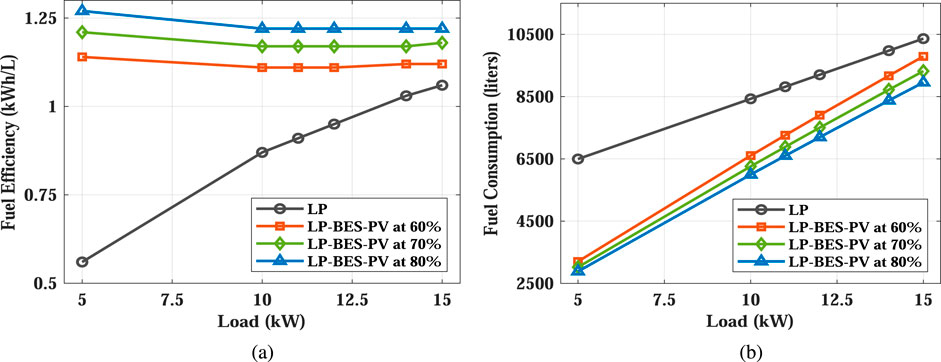
Figure 6. Fuel efficiency and fuel consumption of hybrid PV system. (a) Fuel efficiency, (b) Fuel consumption.
Figure 7 compares the fuel efficiency and fuel consumption of the LP-only system with the hybrid configurations (LP-BES and LP-BES-PV) at 60% generator loading. For the LP-BES-PV case, two curves are shown—one based on simulated PV output and the other incorporating actual 24-h solar energy generation data collected from the hybrid system deployed in Kansas City. As shown, the curve derived from field data aligns closely with the theoretical estimates, providing partial validation of the simulation framework.
The results confirm that the hybrid configuration with PV and BES achieves significantly higher fuel efficiency compared to the LP-only system. However, the relative advantage decreases as the load increases, narrowing the efficiency gap. This trend highlights the importance of evaluating not only technical performance but also operational priorities. For system owners and operators, the added value of BES and PV must be considered against the additional capital expenditure (CAPEX), especially in applications where reliability, refueling logistics and generator maintenance are critical operational concerns.
The improvement in fuel efficiency and the resulting fuel consumption savings are higher for the hybrid PV system when the LP generator operates at 80% loading. A summary of the monthly fuel savings for the hybrid PV system across various loading conditions is provided in Table 5. As shown in the table, the fuel savings are higher at 80% loading compared to 60% loading scenario.
5.2 Environmental impact assessment of the hybrid power system
To quantify the environmental benefits of the hybrid power system, we determined the reduction in greenhouse gas (GHG) emissions achieved by integrating BES and PV generation with an LP generator. Specifically, we evaluated the annual carbon dioxide
The analysis was based on the U.S. Environmental Protection Agency (EPA) emission factor for propane combustion, which is:
The monthly reduction in
where:
•
•
•
To calculate annual
The above calculation was applied across all three loading scenarios (5 kW, 10 kW, and 15 kW) and for both generator loading conditions (60% and 80%). Table 6 summarizes the annual
5.3 Impact of temperature on the fuel efficiency of the hybrid system
5.3.1 Impact of temperature on the fuel efficiency of LP generator
The rated output of the LP generator decreases by 4% for every 5 °C increase above 24°C as per the data provided by HCI. Therefore, at 104°F, the rated output decreases by 12.8%. As the ambient temperature rises, the density of the air decreases, leading to a reduction in the oxygen available for combustion. This results in a less efficient combustion process, leading to higher fuel consumption for the same power output. The impact of higher temperature on the fuel efficiency of the LP generator is shown in Figure 8. It is clear from the figure that there is a drop in fuel efficiency at 104°F compared to the fuel efficiency at ambient temperature.
5.3.2 Impact of temperature on the fuel efficiency of hybrid system with LP and BES
The HVAC draws additional power to maintain the battery storage at an optimum temperature of 77°F, reducing the fuel efficiency.
At 104°F which represents a region such as Nigeria, the cooling capacity required to maintain the temperature at 77°F is 2.74 kW.
At 14°F which represents a region such as Canada, the heat required to maintain the temperature at 77°F is 0.93 kW.
The calculations associated with determining the cooling capacity required to maintain the temperature at 77°F are shown below based on the data provided in Table 7.
Total internal heat load in
Enclosure heat transfer (HT) in W
The cooling capacity required
The duty cycle and fuel efficiency are calculated based on Equations 11 and 12 for the LP-BES-PV system as shown in Equations 14 and 15.
Table 8 shows the fuel efficiency and fuel consumption of the hybrid PV system at different operating points of the LP generator.
The data presented in Table 8 indicates that the fuel efficiency of the hybrid PV system at 104°F is greater when the LP operates at 80% loading, in contrast to its performance at 60% loading. Moreover, it’s important to note that the fuel efficiency of the hybrid PV system is higher at 77°F compared to its efficiency at 104°F for a given operating point, as illustrated in Figure 9. While the fuel efficiency at 104°F increases with the LP operating at 80%, it remains lower than the fuel efficiency at 77°F and LP at 60% loading. The fuel efficiency of the hybrid PV system can be enhanced by operating the LP at 80% of its rated capacity, as shown in Figure 10. However, it’s important to highlight that the advantages of employing a hybrid system diminish as the load increases. This reduction in efficiency is attributed to the smaller PV panel and the extended time required to charge the battery storage at higher load levels.
5.4 Economic analysis
In this section, we conduct a comparative analysis of the total cost of ownership between a direct LP system and hybrid systems equipped with BES and PV. The essential data required for this economic assessment is provided by HCI and presented in Table 9.
The total cost of ownership (TCO) is computed for a 20-year duration, incorporating the following standards provided by HCI:
•The annual maintenance expense for the propane generator is estimated at 10% of the LP generator’s initial cost.
•The annual maintenance cost for the BES and PV panel is calculated as 5% of the initial capital investment (CI).
•Maintenance costs (MC) are presumed to increase by 3% each year.
•The BES is replaced every 10 years accounting for degradation caused by regular charge-discharge cycling.
•The PV modules have an expected service life of 25 years and the LP generator has a lifespan of 20 years.
Therefore, the maintenance cost for 20 years is determined using Equation 16. The expressions to determine the operational cost and the total cost of ownership are presented in Equations 17 and 18.
To account for uncertainties related to inflation, fuel prices and future technological advancements, a sensitivity analysis is presented in Section 5.5, exploring variations in battery cost, fuel price and solar energy output.
Table 10 provides a comprehensive overview of the TCO for three distinct systems: LP-only, LP-BES and LP-BES-PV. The analysis has been carried out for 5 kW and 15 kW loads at the 60% and 80% LP generator operating points in three different regions, i.e., Kansas City, Nigeria and Canada.
The data presented in Table 10 underscores that employing a hybrid system for a 5 kW load leads to substantial economic benefits. These savings can be further enhanced by running the hybrid system at an 80% load. Conversely, providing power for a 15 kW load through a hybrid system does not yield any economic advantages, even when the LP generator operates at 80% of its rated capacity. The minor savings achieved in Canada by incorporating a PV panel are negligible over a 20-year period. It must also be noted that the hybrid system with LP and BES is not feasible in Nigeria and Canada when the LP operates at 60% since it cannot charge the BES after it caters to the load and HVAC demand.
5.4.1 Impact of PV on the cost of ownership
This section explores the influence of incorporating extra PV panels on the long-term cost of ownership for the hybrid system spanning 20 years. The additional PV panels are ground-mounted to power the HPS. The economic assessment has been carried out based on the assumptions and the data provided in Tables 2, 4 and 9. The analysis is performed for three regions: Kansas City, Nigeria and Canada to demonstrate the effectiveness of the HPS at different temperatures.
Table 11 illustrates how the total cost of ownership in Kansas City, Nigeria and Canada changes as the number of PV panels is adjusted. A careful examination of the table reveals a consistent trend: as the number of PV panels increases, the cost of ownership decreases across all loads and operating conditions. Notably, the cost of ownership is lower when operating at 80% loading in comparison to 60% loading. Even if the LP generator has to be completely replaced three times by operating at 80%, the cost is still lower than running at 60%.
The cost of ownership is at its most favorable when the HPS is in conjunction with PV panels, surpassing both the configurations involving battery storage and a direct LP generator. Notably, when handling a 15 kW load at 60% loading, direct LP generator operation is economically advantageous if the number of PV panels is less than three. Nevertheless, once the number of PV panels exceeds three, the ownership cost declines compared to the cost of direct LP generator configuration mentioned in Table 10. To be conservative, over a 20-year lifespan, one would also expect hail and other natural disasters.
In case of Nigeria, where the average temperature soars to 104°F the pattern is similar to the one observed in the KC region. The heightened solar insolation in Nigeria indeed yields greater energy output from the PV panels. However, this advantage is counteracted by the HVAC load, which consumes 2.74 kW (as detailed in Section 5.3) to maintain the battery storage and the electronics within the HPS at an ambient temperature of 77°F. Consequently, due to the additional power demanded by the HVAC system, the HPS cannot meet the 15 kW load demand when the LP operates at 60% loading. Although it manages to satisfy the 15 kW load when the number of PV panels is increased to five, the cost of ownership ($2,539,039.96) surpasses that of the direct LP generator case ($2,444,193.34).
In Canada, where the average temperature is 14°F the observed trend aligns with the patterns seen in KC and Nigeria. The cost of ownership in Canada is higher compared to the KC region due to the lower solar insolation. Additionally, the HVAC system requires an extra 0.93 kW of power (as detailed in Section 5.3) to maintain the ambient temperature at 77°F. Some level of savings are obtained when the HPS operates with five PV panels with the LP generator operating at 60% and 80% capability. However, the savings are negligible over a 20 year period.
5.4.2 Profit margin analysis
This section analyzes the profit margins achieved using the HPS equipped with five PV panels. In this context, profit margin refers to the difference in ownership costs between the HPS with five PV panels and the direct LP generator. Table 12 provides insights into the profit margins for loads of 5 kW and 15 kW in the three regions of interest: KC, Canada and Nigeria. Notably, Table 12 demonstrates that Nigeria exhibits the highest profit margin. This phenomenon can be attributed to the elevated cost of propane in Nigeria, which subsequently increases the ownership costs associated with the direct LP generator configuration. Furthermore, the profit margin in Canada surpasses that of Kansas City, driven by the relatively higher propane costs in Canada compared to those in Kansas. It is essential to recognize that the increased propane costs amplify the disparity between the ownership costs of the direct LP generator and the LP-BES-PV configuration with five panels, thereby enhancing the overall profit margin. For the 15 kW load scenario presented in Table 12, no profit margin is observed when the HPS operates in Canada and Nigeria with the LP generator running at 60% capacity. However, operating the LP generator at 80% capacity yields some level of profits across all regions.
5.5 Sensitivity analysis
To evaluate the robustness of the hybrid system’s economic performance under real-world uncertainties, a sensitivity analysis was conducted by varying three key parameters: propane fuel price, solar energy output and battery cost. The outcomes of this analysis are illustrated in Figure 11, which presents a comparative bar graph showing the variation in the 20-year TCO for both LP-only and hybrid systems across each scenario. These parameters were selected based on their high impact on system economics and their inherent variability due to environmental, market, and technological factors.
5.5.1 Fuel price variation
Propane fuel cost is a dominant driver of operating expenses in both LP-only and hybrid system configurations. Based on U.S. Energy Information Administration (EIA) data, residential propane prices in the United States fluctuated by approximately
The results show that the LP-only system is highly sensitive to changes in fuel price, with significant impacts on TCO. In contrast, the hybrid system demonstrates greater resilience due to its partial reliance on PV and BES, which substantially offset propane consumption. As a result, the hybrid system maintains a lower TCO than the LP-only configuration across both low and high fuel price scenarios.
5.5.2 Solar output variation
The performance of the PV subsystem was analyzed by varying solar energy output by
5.5.3 Battery cost variation
The battery energy storage system (BESS) constitutes a significant portion of the hybrid system’s capital cost. Given recent global trends and fluctuations in lithium-ion battery markets, a
As expected, changes in battery cost directly affect the capital investment component of the hybrid system. A
5.5.4 Summary of findings
The results of this sensitivity analysis are summarized in Figure 11. Across all parameter variations, the hybrid LP-BES-PV system exhibits strong economic performance and resilience. While each factor—fuel price, solar irradiance and battery cost individually influences the TCO, the hybrid system consistently outperforms the LP-only alternative. These findings reinforce the hybrid configuration’s suitability for long-term, off-grid deployments where fuel logistics, solar availability and technology costs are subject to variability.
5.6 Comparative analysis of diesel and propane based hybrid system
To further evaluate the performance of the HPS, an additional analysis was conducted using a 30 kW diesel generator (DG) in place of the LP generator. Fuel efficiency data for the diesel generator was obtained from the manufacturer’s datasheet available on the Generac website Generac (2016). The diesel generator’s fuel efficiency across various loading conditions is presented in Table A2 of the Appendix. The same analytical approach used for the LP based hybrid system was applied to the DG configuration.
The results reveal trends consistent with those previously observed. As shown in Table 13, higher fuel savings are achieved when the hybrid system with a diesel generator operates at 80% loading compared to 60% loading. Figures 12a,b compare fuel efficiency and fuel consumption for LP and DG based systems under varying temperature conditions. The diesel based system consistently demonstrates higher fuel efficiency and lower fuel use, which translates into reduced operational costs.
Despite the fuel efficiency advantages of diesel generators particularly under high load conditions, it is important to consider the operational context in which HCI hybrid systems are deployed. The LP based hybrid systems currently deployed by HCI Energy serve as the primary power source for mission-critical applications in remote regions, such as powering telecommunication towers. In these environments, system reliability, low maintenance requirements and long-term fuel stability are critical.
LP generators offer several operational advantages in this context. Propane’s superior chemical stability enables long-term storage without degradation, making it ideal for remote installations where fuel turnover is infrequent. In contrast, diesel fuel is prone to microbial growth and oxidation over time, which can compromise fuel quality and system reliability Ludwiczak et al. (2025). Moreover, propane combustion results in fewer particulates and lower nitrogen oxide emissions than diesel, reducing engine wear and tear and minimizing maintenance factors that are essential in remote areas with limited service access.
While LP based hybrid systems remain optimal for off-grid, mission-critical applications, HCI Energy recognizes the operational and economic benefits of diesel generators in other contexts. The company plans to integrate diesel generator based hybrid systems as backup power solutions in both rural and urban areas where fuel resupply and maintenance services are more readily available. This dual-path strategy allows for application specific optimization based on environmental, logistical and economic factors.
6 Policy implications
The findings of this study highlight the potential for hybrid power systems integrating propane generators, PV panels and battery energy storage to influence sustainable energy policy for remote and mission-critical applications. Our analysis demonstrates that such systems can reduce propane fuel consumption by over 50% at low load levels, avoiding up to 1,198 metric tons of
Beyond environmental and economic benefits, hybrid systems also play a critical role in improving energy access and equity. By enabling consistent, reliable and affordable electricity in areas with limited or no grid connectivity, these systems can significantly increase per capita electricity consumption in rural communities. This directly supports essential services such as lighting, refrigeration, healthcare, education and digital connectivity contributing to local economic development and improved quality of life. Moreover, the hybrid approach aligns closely with the U.S. Department of Energy’s Energy Improvements in Rural or Remote Areas (ERA) initiative, offering a scalable and resilient solution that reduces fuel dependency, enhances energy security and empowers communities through greater energy independence U.S. Department of Energy (2025).
7 Limitations of the study
While this study provides a comprehensive analysis of the hybrid power supply system under various configurations and environmental conditions, several limitations should be acknowledged. First, the analysis is based on Excel based simulations rather than experimentally collected data. Although the inputs are grounded in manufacturer specifications and real-world deployment scenarios, practical validation of system performance is planned for future phases of this work. Second, the study focuses on three representative locations—Canada, Nigeria and Kansas City to capture a range of temperature and solar conditions. While informative, the results may not fully represent performance in all geographic regions. Future work will expand the analysis to include a broader set of climatic zones and incorporate empirical data to enhance model fidelity.
8 Conclusion
This paper provides a comprehensive analysis of the fuel efficiency and economic viability of a hybrid power supply system that integrates an LP generator, BES and PV panels. The findings indicate that operating the LP generator at 80% loading improves fuel efficiency by approximately 13% compared to operation at 60% loading, particularly under a 5 kW demand scenario. When integrated with BES and PV, the system achieves a reduction in monthly fuel consumption of over 55%, resulting in a total fuel savings of more than 18,000 gallons over a 20-year period. These improvements lead to a total cost of ownership reduction of up to 32% when compared to the LP only configuration. However, it is noted that the hybrid system’s fuel efficiency diminishes at higher temperatures, primarily due to the increased power demands from the HVAC system. The analysis also highlights the profitability of implementing multiple PV panels, especially in regions like Nigeria, where high solar insolation can effectively mitigate additional power consumption for temperature control. While the hybrid power system demonstrates marked advantages in fuel efficiency and return on investment for lower load scenarios, it becomes economically unfeasible when applied to higher loads such as 15 kW.
The system also demonstrates substantial environmental benefits, with a reduction of over 65 metric tons of
Data availability statement
The original contributions presented in the study are included in the article/Supplementary Material, further inquiries can be directed to the corresponding author.
Author contributions
PG: Conceptualization, Data curation, Formal Analysis, Investigation, Methodology, Project administration, Resources, Software, Supervision, Validation, Visualization, Writing – original draft, Writing – review and editing. SY: Investigation, Software, Visualization, Writing – original draft, Writing – review and editing. MA: Investigation, Visualization, Writing – original draft, Writing – review and editing. AN: Conceptualization, Funding acquisition, Project administration, Supervision, Validation, Writing – review and editing.
Funding
The author(s) declare that financial support was received for the research and/or publication of this article. This project was funded by Missouri Institute of Defense and Energy (MIDE) and HCI Energy.
Acknowledgments
The authors would like to thank HCI Energy for providing all the data required to conduct the analysis in this paper.
Conflict of interest
The authors declare that the research was conducted in the absence of any commercial or financial relationships that could be construed as a potential conflict of interest.
The authors declare that this study received funding from HCI Energy. The funder had the following involvement in the study: Provided preliminary data to carry out the case studies.
Generative AI statement
The author(s) declare that no Generative AI was used in the creation of this manuscript.
Publisher’s note
All claims expressed in this article are solely those of the authors and do not necessarily represent those of their affiliated organizations, or those of the publisher, the editors and the reviewers. Any product that may be evaluated in this article, or claim that may be made by its manufacturer, is not guaranteed or endorsed by the publisher.
References
Abdulmula, A., Sopian, K., Ludin, N., Haw, L., Elbreki, A., Aldawi, F., et al. (2022). Micropower system optimization for the telecommunication towers based on various renewable energy sources. Int. J. Electr. Comput. Eng. (IJECE) 12, 1069–1076. doi:10.11591/ijece.v12i2.pp1069-1076
Alam, M. N., Akib, I. C., Rahman, M. Z., and Kabir, M. A. (2024). “Techno-economic analysis of solar pv-fc hybrid energy systems: an exploratory perspective,” in 2024 6th international conference on electrical engineering and information communication technology (ICEEICT), 1281–1285. doi:10.1109/ICEEICT62016.2024.10534525
Ali, M. B., Altamimi, A., Kazmi, S. A. A., Khan, Z. A., and Alyami, S. (2024). Sustainable growth in the telecom industry through hybrid renewable energy integration: A technical, energy, economic and environmental (3e) analysis. Sustainability 16, 6180. doi:10.3390/su16146180
Alkhrijh, M., and Wonsuk, K. (2024). “A study of off-grid environment-friendly power supplying solution to telecom towers in neom,” in 2024 7th asia conference on energy and electrical engineering (ACEEE), 267–272. doi:10.1109/ACEEE62329.2024.10651775
Asghar, F., Hussain, M. I., Alshahrani, F. A., Akhtar, M. I., Amjad, W., Shahzad, M., et al. (2024). Technoeconomic analysis of standalone hybrid renewable energy systems for telecommunication sector under different climatic conditions in Saudi Arabia. Energy Rep. 11, 4067–4084. doi:10.1016/j.egyr.2024.03.055
Deevela, K. T. S. B. N. R., Kandpal, T. C., and Singh, B. (2024). A review of renewable energy based power supply options for telecom towers. Environ. Dev. Sustain. 26, 2897–2964. doi:10.1007/s10668-023-02917-7
Deevela, S. B., Rao, N., and Kandpal, T. C. (2021). Techno-economics of solar pv array-based hybrid systems for powering telecom towers. Environ. Dev. Sustain. 23, 17003–17029. doi:10.1007/s10668-021-01379-z
Ferrier, L., Ibrahim, H., Issa, M., and Ilinca, A. (2021). State of the art of telecommunication systems in isolated and constrained areas. Sensors 21, 3073. doi:10.3390/s21093073
Hassan, Q., Algburi, S., Sameen, A. Z., Salman, H. M., and Jaszczur, M. (2023). A review of hybrid renewable energy systems: solar and wind-powered solutions: challenges, opportunities, and policy implications. Results Eng. 20, 101621. doi:10.1016/j.rineng.2023.101621
HCI (2024). Renewable alternative. energy solutions. Available online at: https://www.hcienergy.com/ (Accessed September 9, 2024).
Jansen, G., Dehouche, Z., and Corrigan, H. (2021). Cost-effective sizing of a hybrid Regenerative Hydrogen Fuel Cell energy storage system for remote and off-grid telecom towers. Int. J. Hydrogen Energy 46, 18153–18166. doi:10.1016/j.ijhydene.2021.02.205
Kumar, N. M., Chopra, S. S., Chand, A. A., Elavarasan, R. M., and Shafiullah, G. (2020). Hybrid renewable energy microgrid for a residential community: a techno-economic and environmental perspective in the context of the sdg7. Sustainability 12, 3944. doi:10.3390/su12103944
Kumar, U. S., and Manoharan, P. (2014). Economic analysis of hybrid power systems (pv/diesel) in different climatic zones of Tamil nadu. Energy Convers. Manag. 80, 469–476. doi:10.1016/j.enconman.2014.01.046
Ludwiczak, A., Zieliński, T., Sibińska, E., Czeszewska-Rosiak, G., Złoch, M., Rudnicka, J., et al. (2025). Comparative analysis of microbial contamination in diesel fuels using maldi-tof ms. Sci. Rep. 15, 4525. doi:10.1038/s41598-025-87713-1
Madziga, M., Rahil, A., and Mansoor, R. (2018). Comparison between three off-grid hybrid systems (solar photovoltaic, diesel generator and battery storage system) for electrification for gwakwani village, South Africa. Environments 5, 57. doi:10.3390/environments5050057
Maoulida, R. D. G. M. F., Aboudou, K., and Ganaoui, M. E. (2021). Pv-wind-diesel system for energy supply on remote area applied for telecommunication towers in Comoros. Open J. Energy Effic. 10, 50–72. doi:10.4236/ojee.2021.102004
Martinho, D. L., Simon Araya, S., Sahlin, S. L., Liso, V., Li, N., and Berg, T. L. (2022). Modeling a hybrid reformed methanol fuel cell–battery system for telecom backup applications. Energies 15, 3218. doi:10.3390/en15093218
National Renewable Energy Laboratory (2024). National solar radiation database (nsrdb). Available online at: https://nsrdb.nrel.gov/(Accessed January 05, 2024).
Qiu, Y., Yuan, C., Tang, X., Tang, J., Zhang, Y., and Bai, X. (2019). “Techno-economic assessment of a pv/sc hybrid power system integrated into 2240 pctc ro-ro ship,” in 2019 8th international conference on renewable energy research and applications (ICRERA), 75–80. doi:10.1109/ICRERA47325.2019.8996535
Rao Deevela, N., Chishti, F., Singh, B., and Kandpal, T. C. (2022). “Ngk-lms control for grid connected solar pv-bes hybrid system to provide electricity to telecom tower,” in 2022 IEEE IAS global conference on emerging technologies (GlobConET), 387–392. doi:10.1109/GlobConET53749.2022.9872421
Rohani, A., Mazlumi, K., and Kord, H. (2010). “Modeling of a hybrid power system for economic analysis and environmental impact in homer,” in 2010 18th Iranian conference on electrical engineering, 819–823. doi:10.1109/IRANIANCEE.2010.5506962
U.S. Department of Energy (2025). Energy improvements in rural or remote areas. Available online at: https://www.energy.gov/oced/era (Accessed April 31, 2025).
Weber, J. A., Gao, W., Kou, X., and Zhai, J. Z. (2015). “Small scale mobile hybrid integrated renewable energy system (hi-res) for rapid recovery and emergency response,” in 2015 seventh annual IEEE green technologies conference, 50–57. doi:10.1109/GREENTECH.2015.35
Zegueur, A., Sebbagh, T., and Metatla, A. (2023). A techno-economic study of a hybrid pv–wind–diesel standalone power system for a rural telecommunication station in northeast Algeria. Eng. Proc. 56, 25. doi:10.3390/ASEC2023-15250
Appendix
Keywords: liquid propane generator (LP), battery energy storage (BES), photovoltaic (PV), fuel efficiency, economic analysis
Citation: Goli P, Yelem S, Alhashem M and N. Caruso A (2025) Fuel efficiency and economic assessment of a hybrid power supply system for mission critical applications. Front. Energy Res. 13:1511978. doi: 10.3389/fenrg.2025.1511978
Received: 15 October 2024; Accepted: 25 April 2025;
Published: 21 May 2025.
Edited by:
Weihao Hu, University of Electronic Science and Technology of China, ChinaReviewed by:
Giovanni Pau, Kore University of Enna, ItalyOlanrewaju Oyewola, Fiji National University, Fiji
Copyright © 2025 Goli, Yelem, Alhashem and N. Caruso. This is an open-access article distributed under the terms of the Creative Commons Attribution License (CC BY). The use, distribution or reproduction in other forums is permitted, provided the original author(s) and the copyright owner(s) are credited and that the original publication in this journal is cited, in accordance with accepted academic practice. No use, distribution or reproduction is permitted which does not comply with these terms.
*Correspondence: Preetham Goli, Z29saXBAdW1rYy5lZHU=
 Preetham Goli
Preetham Goli Srikanth Yelem
Srikanth Yelem Mohammed Alhashem
Mohammed Alhashem Anthony N. Caruso
Anthony N. Caruso

